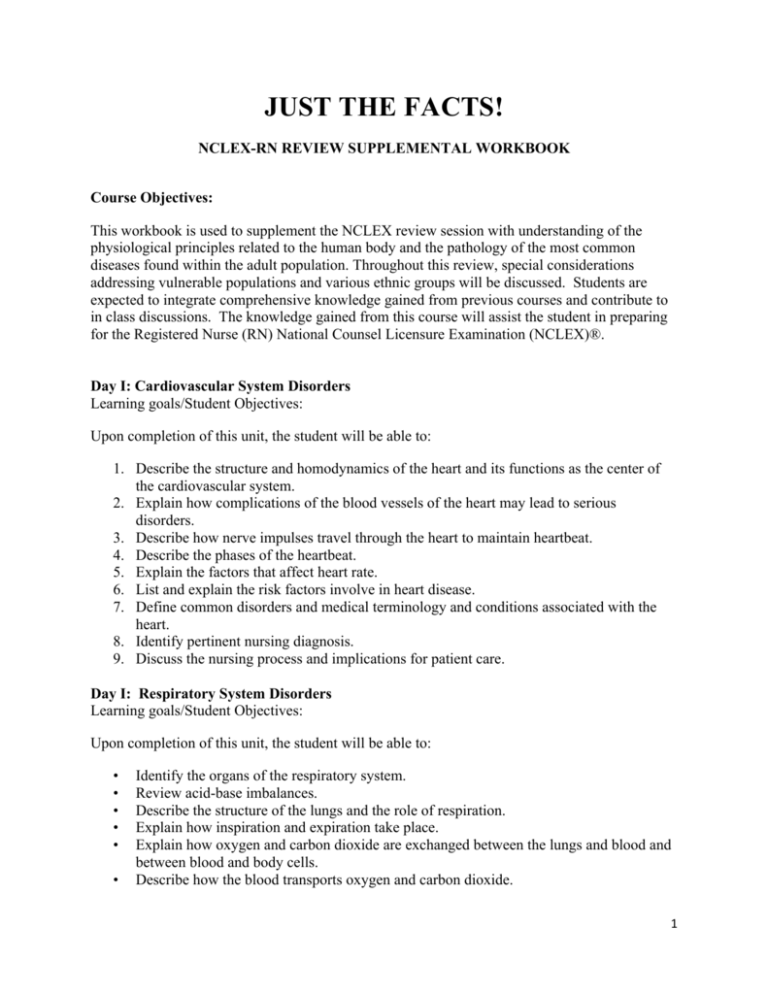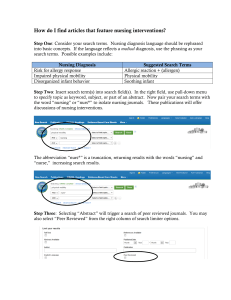
JUST THE FACTS!
NCLEX-RN REVIEW SUPPLEMENTAL WORKBOOK
Course Objectives:
This workbook is used to supplement the NCLEX review session with understanding of the
physiological principles related to the human body and the pathology of the most common
diseases found within the adult population. Throughout this review, special considerations
addressing vulnerable populations and various ethnic groups will be discussed. Students are
expected to integrate comprehensive knowledge gained from previous courses and contribute to
in class discussions. The knowledge gained from this course will assist the student in preparing
for the Registered Nurse (RN) National Counsel Licensure Examination (NCLEX)®.
Day I: Cardiovascular System Disorders
Learning goals/Student Objectives:
Upon completion of this unit, the student will be able to:
1. Describe the structure and homodynamics of the heart and its functions as the center of
the cardiovascular system.
2. Explain how complications of the blood vessels of the heart may lead to serious
disorders.
3. Describe how nerve impulses travel through the heart to maintain heartbeat.
4. Describe the phases of the heartbeat.
5. Explain the factors that affect heart rate.
6. List and explain the risk factors involve in heart disease.
7. Define common disorders and medical terminology and conditions associated with the
heart.
8. Identify pertinent nursing diagnosis.
9. Discuss the nursing process and implications for patient care.
Day I: Respiratory System Disorders
Learning goals/Student Objectives:
Upon completion of this unit, the student will be able to:
•
•
•
•
•
•
Identify the organs of the respiratory system.
Review acid-base imbalances.
Describe the structure of the lungs and the role of respiration.
Explain how inspiration and expiration take place.
Explain how oxygen and carbon dioxide are exchanged between the lungs and blood and
between blood and body cells.
Describe how the blood transports oxygen and carbon dioxide.
1 •
•
•
Define common disorders and medical terminology associated with the respiratory
system.
Identify pertinent nursing diagnosis.
Discuss the nursing process and implications for patient care.
Day II: Endocrine, Hematologic & Immune System Disorders
Learning goals/Student Objectives:
Upon completion of this unit, the student will be able to:
•
•
•
•
•
•
•
•
•
•
•
•
•
•
Discuss the importance of the endocrine system in regulating homeostasis.
Describe how hormones act on body cells.
Explain how the levels of hormone in the blood are regulated.
Describe the location and function of the endocrine
Explain how the pituitary gland is related to the hypothalamus of the brain.
Describe how the body responds to stress and explain how stress and disease are related.
Review of basic function of the immune system
Differentiate between antibodies and antigens
Describe the function of the major organs involved in the immunity process
Differentiate between acquired immunity and artificial immunity
Define the role T-cells and B-Cells
Identify common medical disorders and terminology associated with the hematologic and
immune system.
Identify pertinent nursing diagnosis.
Discuss the nursing process and implications for patient care.
Day II: Musculoskeletal & Integumentary System Disorders
Learning Goals/Student Objectives:
Upon completion of this unit, the student will be able to:
•
•
•
•
•
•
•
Describe the structure and function of the musculoskeletal system
Describe the structure and function of the integumentary system
Identify the layers of the skin and the stages of burns
List and explain the risk factors involve in heart disease.
Define common disorders and medical terminology and conditions associated with the
musculoskeletal and integumentary system.
Identify pertinent nursing diagnosis.
Discuss the nursing process and implications for patient care.
2 Day III: Nervous System Disorders
Learning Goals/Student Objectives:
Upon completion of this unit, the student will be able to:
•
•
•
•
•
•
•
•
Describe the main characteristics of the nervous system.
Compare the somatic and autonomic nervous system.
Describe the functions of the central nervous system.
Identify the 12 cranial nerves and their function.
Explain the sympathetic and parasympathetic response.
Identify common medical disorders and terminology associated with the nervous system.
Identify pertinent nursing diagnosis.
Discuss the nursing process and implications for patient care.
Day III: Genitourinary & Gastrointestinal Disorders
Learning Goals/Student Objectives:
Upon completion of this unit, the student will be able to:
•
•
•
•
•
•
•
•
•
•
•
•
•
•
•
List the organs of the urinary system and describe how they help to maintain
homeostasis.
Describe how the kidneys function to filter blood and regulate volume, chemical
composition, and pH.
Review of the 3 phases of urine formation.
Explain the function of the ureters, bladder, and urethra.
Explain the Renin-Angiotension Mechanism.
Describe common disorders, medical terminology, and conditions related to the urinary
system.
Review of basic processes involved in digestion.
Identify the organs that are instrumental in the digestive system.
Describe the various phases that are involved in swallowing.
Explain how and where food is broken down and absorbed.
Define the role of the stomach, small and large intestine.
Explain how the pancreas, liver, and gallbladder participates in digestion.
Identify common medical disorders and terminology associated with the digestion
system.
Identify pertinent nursing diagnosis.
Discuss the nursing process and implications for patient care.
3 Day III: Pharmacology Review
Learning Goals/Student Objectives:
Upon completion of this unit, the student will be able to:
•
•
•
•
Identify key terms, concepts, and basic applications of specific drugs associated with the
major health systems.
Use a systematic approach to studying for the NCLEX.
Identify safe, ethical, and legal principles of nursing in regards to drug administration in
the adult population.
Describe characteristics of select drug groups and identify major issues/concerns in drug
therapy.
STATEMENT OF LIABILITY
The information contained in the workbook has been thoroughly reviewed and checked for accuracy. However, clinical
practice is a dynamic process and new information becomes available daily. Prudent practice dictates that the student
and/or clinician consult further sources prior to applying or solely relying on information in this book. Joseph Morris
disclaims any liability, loss, injury, or damage incurred as a consequence, directly or indirectly, from the use and
application of any of the contents of this volume
All rights reserved. 2008
4 MEDICAL-­‐SURGICAL
Angina Description: Chest pain related to decrease in oxygen supply to the myocardium, may lead to heart attack (MI). Etiology/Risk Factors: Notes: 1. Stable, Unstable, Prinzmetal, Microvascular 2. MI Other factors may include: Stress, vasospasms, aortic stenosis 3. Stimulants 4. Smoking Note: Morphine is often used for chest pain that is relieved from nitrates 5. Arthrosclerosis Assessment/Monitor/Labs/Medication: 1. Tachycardia, Palpitations, Anxiety, Dyspnea 2. P.Q.R.S.T 3. H&P Exam 4. ECG, Chest X-­‐Ray P:_____________________ Q:_____________________ R:_____________________ S:_____________________ T:_____________________ 5. CK-­‐MB, Myoglobin, Troponin, CBC 6. Antiplatelets, Anticoagulants 7. Beta Blockers, Calcium Channel Blockers
Nitrates, ACE inhibitors: Nursing Diagnosis: 1. Acute Pain 2. Decreased Cardiac Output 3. Ineffective Individual Coping Nursing Interventions: 3. Teach client to avoid strenuous exercise 4. Smoking cessation, Drug rehab: AA, NA 5. Diet assessment 6. Stress reduction 1. Pain management 2. Monitor I/O’s, Vital Signs, Post-­‐Op Stint Placement __________________________________________________________________________________________________ S.O.A.R SERVICES® JUST THE FACTS 2 MEDICAL-­‐SURGICAL
Alzheimer’s Disease Description: A chronic cognitive disorder that is characterized by an accumulation of Amlyoid plaque and neuro-­‐fibers that tangle in the brain. Etiology/Risk Factors: Notes: 1. Age 2. Race 3. Gender: Male vs. Female Safety, safety, safety is a major concern with this population. 4. Genetics 5. Downs Syndrome Assessment/Monitor/Labs: 1. 3 stages of disease progression 2. Stage I : short term memory loss 3. Stage II: Behavior changes, agitation aggression , wandering, cursing, etc 4. stage III: Total dependence with ADLS 5. Screening tool: MMSE 6. Autopsy: Most definitive test 7. Labs: BUN/Cr., CBC, WBC, LFT Nursing Diagnosis: 1. High risk for Injury 2. Altered Nutrition less than body requirements 3. Anticipatory Grief Nursing Interventions: 2. Monitor Bowel and bladder management 3. Pharmacological: Aricept, Namenda, MVI 4. Non-­‐pharmacological: Music, Aroma Therapy 5. Symptom management 6. Safety & Hazardous monitoring 1. Fall Precaution __________________________________________________________________________________________________ S.O.A.R SERVICES® JUST THE FACTS 3






